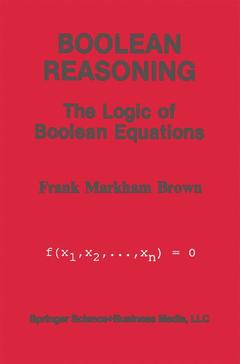Boolean Reasoning, Softcover reprint of the original 1st ed. 1990 The Logic of Boolean Equations
Langue : Anglais
Auteur : Brown Frank Markham

This book is about the logic of Boolean equations. Such equations were central in the "algebra of logic" created in 1847 by Boole [12, 13] and devel oped by others, notably Schroder [178], in the remainder of the nineteenth century. Boolean equations are also the language by which digital circuits are described today. Logicians in the twentieth century have abandoned Boole's equation based logic in favor of the more powerful predicate calculus. As a result, digital engineers-and others who use Boole's language routinely-remain largely unaware of its utility as a medium for reasoning. The aim of this book, accordingly, is to is to present a systematic outline of the logic of Boolean equations, in the hope that Boole's methods may prove useful in solving present-day problems. Two Logical Languages Logic seeks to reduce reasoning to calculation. Two main languages have been developed to achieve that object: Boole's "algebra of logic" and the predicate calculus. Boole's approach was to represent classes (e. g. , happy creatures, things productive of pleasure) by symbols and to represent logical statements as equations to be solved. His formulation proved inadequate, however, to represent ordinary discourse. A number of nineteenth-century logicians, including Jevons [94], Poretsky [159], Schroder [178], Venn [210], and Whitehead [212, 213], sought an improved formulation based on ex tensions or modifications of Boole's algebra. These efforts met with only limited success.
1 Fundamental Concepts.- 1.1 Formulas.- 1.2 Propositions and Predicates.- 1.3 Sets.- 1.4 Operations on Sets.- 1.5 Partitions.- 1.6 Relations.- 1.7 Functions.- 1.8 Operations and Algebraic Systems.- 2 Boolean Algebras.- 2.1 Postulates for a Boolean Algebra.- 2.2 Examples of Boolean Algebras.- 2.2.1 The Algebra of Classes (Subsets of a Set).- 2.2.2 The Algebra of Propositional Functions.- 2.2.3 Arithmetic Boolean Algebras.- 2.2.4 The Two-Element Boolean Algebra.- 2.2.5 Summary of Examples.- 2.3 The Stone Representation Theorem.- 2.4 The Inclusion-Relation.- 2.4.1 Intervals.- 2.5 Some Useful Properties.- 2.6 n-Variable Boolean Formulas.- 2.7 n-Variable Boolean Functions.- 2.8 Boole’s Expansion Theorem.- 2.9 The Minterm Canonical Form.- 2.9.1 Truth-tables.- 2.9.2 Maps.- 2.10 The Löwenheim-Müller Verification Theorem.- 2.11 Switching Functions.- 2.12 Incompletely-Specified Boolean Functions.- 2.13 Boolean Algebras of Boolean Functions.- 2.13.1 Free Boolean Algebras.- 2.14 Orthonormal Expansions.- 2.14.1 Löwenheim’s Expansions.- 2.15 Boolean Quotient.- 2.16 The Boolean Derivative.- 2.17 Recursive Definition of Boolean Functions.- 2.18 What Good are “Big” Boolean Algebras?.- 3 The Blake Canonical Form.- 3.1 Definitions and Terminology.- 3.2 Syllogistic & Blake Canonical Formulas.- 3.3 Generation of BCF(f).- 3.4 Exhaustion of Implicants.- 3.5 Iterated Consensus.- 3.5.1 Quine’s method.- 3.5.2 Successive extraction.- 3.6 Multiplication.- 3.6.1 Recursive multiplication.- 3.6.2 Combining multiplication and iterated consensus.- 3.6.3 Unwanted syllogistic formulas.- 4 Boolean Analysis.- 4.1 Review of Elementary Properties.- 4.2 Boolean Systems.- 4.2.1 Antecedent, Consequent, and Equivalent Systems.- 4.2.2 Solutions.- 4.3 Reduction.- 4.4 The Extended Verification Theorem.- 4.5 Poretsky’s Law of Forms.- 4.6 Boolean Constraints.- 4.7 Elimination.- 4.8 Eliminants.- 4.9 Rudundant Variables.- 4.10 Substitution.- 4.11 The Tautology Problem.- 4.11.1 Testing for Tautology.- 4.11.2 The Sum-to-One Theorem.- 4.11.3 Nearly-Minimal SOP Formulas.- 5 Syllogistic Reasoning.- 5.1 The Principle of Assertion.- 5.2 Deduction by Consensus.- 5.3 Syllogistic Formulas.- 5.4 Clausal Form.- 5.5 Producing and Verifying Consequents.- 5.5.1 Producing Consequents.- 5.5.2 Verifying Consequents.- 5.5.3 Comparison of Clauses.- 5.6 Class-Logic.- 5.7 Selective Deduction.- 5.8 Functional Relations.- 5.9 Dependent Sets of Functions.- 5.10 Sum-to-One Subsets.- 5.11 Irredundant Formulas.- 6 Solution of Boolean Equations.- 6.1 Particular Solutions and Consistency.- 6.2 General Solutions.- 6.3 Subsumptive General Solutions.- 6.3.1 Successive Elimination.- 6.3.2 Deriving Eliminants from Maps.- 6.3.3 Recurrent Covers and Subsumptive Solutions.- 6.3.4 Simplified Subsumptive Solutions.- 6.3.5 Simplification via Marquand Diagrams.- 6.4 Parametric General Solutions.- 6.4.1 Successive Elimination.- 6.4.2 Parametric Solutions based on Recurrent Covers.- 6.4.3 Löwenheim’s Formula.- 7 Functional Deduction.- 7.1 Functionally Deducible Arguments.- 7.2 Eliminable and Determining Subsets.- 7.2.1 u-Eliminable Subsets.- 7.2.2 u-Determining Subsets.- 7.2.3 Calculation of Minimal u-Determining Subsets.- 8 Boolean Identification.- 8.1 Parametric and Diagnostic Models.- 8.1.1 Parametric Models.- 8.1.2 The Diagnostic Axiom.- 8.1.3 Diagnostic Equations and Functions.- 8.1.4 Augmentation.- 8.2 Adaptive Identification.- 8.2.1 Initial and Terminal Specifications.- 8.2.2 Updating the Model.- 8.2.3 Effective Inputs.- 8.2.4 Test-Procedure.- 9 Recursive Realizations of Combinational Circuits.- 9.1 The Design-Process.- 9.2 Specifications.- 9.2.1 Specification-Formats.- 9.2.2 Consistent Specifications.- 9.3 Tabular Specifications.- 9.4 Strongly Combinational Solutions.- 9.5 Least-Cost Recursive Solutions.- 9.6 Constructing Recursive Solutions.- 9.6.1 The Procedure.- 9.6.2 An Implementation using BORIS.- A Syllogistic Formulas.- A.1 Absorptive Formulas.- A.2 Syllogistic Formulas.- A.3 Prime Implicants.- A.4 The Blake Canonical Form.
Date de parution : 11-2012
Ouvrage de 276 p.
15.5x23.5 cm
Disponible chez l'éditeur (délai d'approvisionnement : 15 jours).
Prix indicatif 168,79 €
Ajouter au panier
© 2024 LAVOISIER S.A.S.



